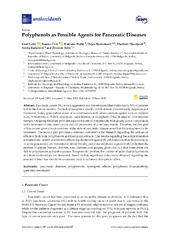Приказ основних података о документу
Polyphenols as Possible Agents for Pancreatic Diseases.
| dc.creator | Gašić, Uroš | |
| dc.creator | Ćirić, Ivanka | |
| dc.creator | Pejčić, Tomislav | |
| dc.creator | Radenković, Dejan | |
| dc.creator | Đorđević, Vladimir | |
| dc.creator | Radulović, Siniša | |
| dc.creator | Tešić, Živoslav | |
| dc.date.accessioned | 2020-09-24T10:01:10Z | |
| dc.date.available | 2020-09-24T10:01:10Z | |
| dc.date.issued | 2020 | |
| dc.identifier.issn | 2076-3921 | |
| dc.identifier.uri | https://www.mdpi.com/2076-3921/9/6/547 | |
| dc.identifier.uri | http://www.ncbi.nlm.nih.gov/pubmed/32585831 | |
| dc.identifier.uri | http://www.pubmedcentral.nih.gov/articlerender.fcgi?artid=PMC7346180 | |
| dc.identifier.uri | https://radar.ibiss.bg.ac.rs/123456789/3891 | |
| dc.description.abstract | Pancreatic cancer (PC) is very aggressive and it is estimated that it kills nearly 50% of patients within the first six months. The lack of symptoms specific to this disease prevents early diagnosis and treatment. Today, gemcitabine alone or in combination with other cytostatic agents such as cisplatin (Cis), 5-fluorouracil (5-FU), irinotecan, capecitabine, or oxaliplatin (Oxa) is used in conventional therapy. Outgoing literature provides data on the use of polyphenols, biologically active compounds, in the treatment of pancreatic cancer and the prevention of acute pancreatitis. Therefore, the first part of this review gives a brief overview of the state of pancreatic disease as well as the procedures for its treatment. The second part provides a detailed overview of the research regarding the anticancer effects of both pure polyphenols and their plant extracts. The results regarding the antiproliferative, antimetastatic, as well as inhibitory effects of polyphenols against PC cell lines as well as the prevention of acute pancreatitis are presented in detail. Finally, particular emphasis is given to the polyphenolic profiles of apples, berries, cherries, sour cherries, and grapes, given the fact that these fruits are rich in polyphenols and anthocyanins. Polyphenolic profiles, the content of individual polyphenols, and their relationships are discussed. Based on this, significant data can be obtained regarding the amount of fruit that should be consumed daily to achieve a therapeutic effect. | en |
| dc.publisher | MDPI AG | |
| dc.relation | info:eu-repo/grantAgreement/MESTD/inst-2020/200007/RS// | |
| dc.relation | info:eu-repo/grantAgreement/MESTD/inst-2020/200288/RS// | |
| dc.relation | info:eu-repo/grantAgreement/MESTD/inst-2020/200168/RS// | |
| dc.rights | openAccess | |
| dc.rights.uri | https://creativecommons.org/licenses/by/4.0/ | |
| dc.source | Antioxidants (Basel, Switzerland) | |
| dc.subject | Pancreatic diseases | |
| dc.subject | Polyphenol bioavailability | |
| dc.subject | Polyphenols | |
| dc.subject | Quercetin | |
| dc.subject | Resveratrol | |
| dc.subject | Synergistic effects | |
| dc.title | Polyphenols as Possible Agents for Pancreatic Diseases. | en |
| dc.type | article | en |
| dc.rights.license | BY | |
| dcterms.abstract | Радуловић, Синиша; Ђорђевић, Владимир; Тешић, Живослав; Раденковић, Дејан; Пејчић, Томислав; Ћирић, Иванка; Гашић, Урош; | |
| dc.rights.holder | © 2020 by the authors. Licensee MDPI, Basel, Switzerland. | |
| dc.citation.issue | 6 | |
| dc.citation.volume | 9 | |
| dc.identifier.doi | 10.3390/antiox9060547 | |
| dc.identifier.pmid | 32585831 | |
| dc.identifier.scopus | 2-s2.0-85090686538 | |
| dc.identifier.wos | 000551230800001 | |
| dc.citation.apa | Gašić, U., Ćirić, I., Pejčić, T., Radenković, D., Djordjević, V., Radulović, S., et al. (2020). Polyphenols as Possible Agents for Pancreatic Diseases. Antioxidants (Basel, Switzerland), 9(6), 547. | |
| dc.citation.vancouver | Gašić U, Ćirić I, Pejčić T, Radenković D, Djordjević V, Radulović S, Tešić Ž. Polyphenols as Possible Agents for Pancreatic Diseases. Antioxidants (Basel, Switzerland). 2020;9(6):547. | |
| dc.citation.spage | 547 | |
| dc.type.version | publishedVersion | |
| dc.identifier.fulltext | https://radar.ibiss.bg.ac.rs/bitstream/id/7355/antioxidants-09-00547.pdf | |
| dc.citation.rank | aM21 |

